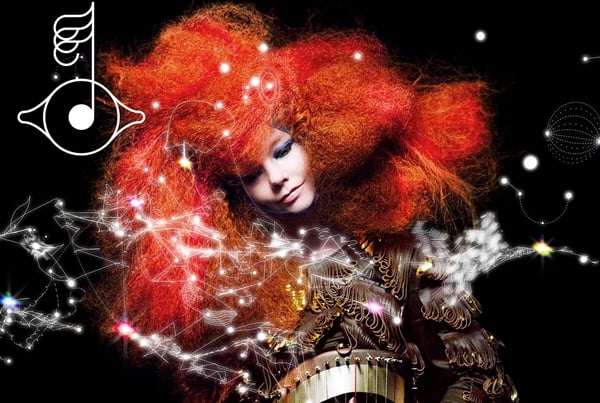There has been an immense volcano building up under the Museum of Modern Art for some time, a well of rage from old-school art fans about its turn towards commerce and celebrity and tourism. The current Björk show, celebrating the Icelandic songstress as, in the words of curator Klaus Biesenbach in the catalogue, an “era-defining artist,” will very likely be occasion for an eruption. You may expect an immense Eyjafjallajökull-sized ash-plume of critical bile to appear over midtown any second now. Because, ladies and gentlemen, this show is bad.
I went in ready to defend MoMA. Björk, I thought, is something interesting, the epitome of a certain kind of odd-duck cool. Many, many reviews will be written about MoMA’s “Björk” show fiasco—scathing, hilarious reviews, reviews whose savagery will be in direct proportion to the smarmy hype leading up to it—based on the premise that celebrating a pop star is by itself bad. I don’t agree. Nothing in principle is bad about a Björk show, or even about a little pop-culture populism.
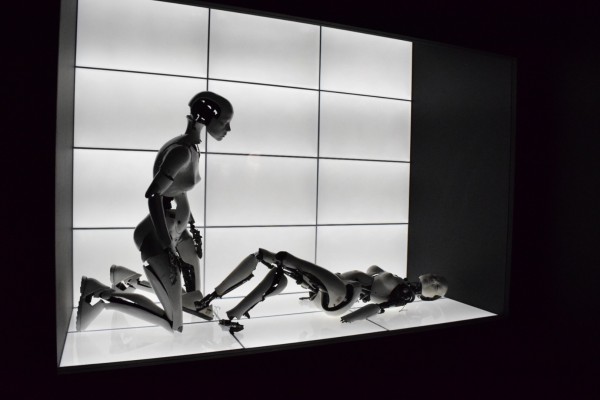
Chris Cunningham, All Is Full of Love Robot (1999).
Photo: Ben Davis.
But the pop turn raises challenges that have to be thoughtfully addressed. It has to be done right. You need to nail it, and MoMA has instead stepped on a nail, or rather, hot lava.
What do you get from the “Björk” experience? The heart of it is something like a cross between a fashion show and a theme-park ride, though that doesn’t make it sound as lame as it actually is. After waiting in a long line—and this is MoMA-plus-a-celebrity, so long lines are part of the experience—you strap on a small iPod and headphones for a “psychographic journey” through Björk’s oeuvre (see Tour Björk’s MoMA Retrospective Through Instagram).
“Take your time,” a soothing voice tells you, introducing the experience, suggesting about “five minutes per room, about 40 minutes overall.” Five minutes to a gallery is a pretty low bar for taking your time, I thought. But then I got in there, and five minutes in these rooms, in fact, seems an eternity, as if you had been plunged into some kind of special purgatory for half-baked celeb worship and muddled exhibition design.
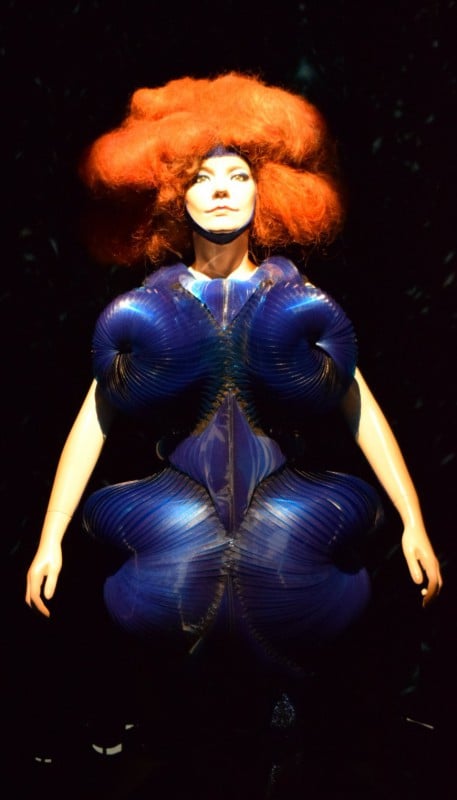
Iris Van Herpen, Biophilia Dress (2011).
Photo: Ben Davis.
Each small chamber is organized around one of Björk’s eight albums, feeling at once cramped and underwhelming. There are props from her various music videos, and some pages of hand-written lyrics and ephemera under glass. Behind a glass display are the love-making robots from Chris Cunningham’s All Is Full of Love video, looking here as if they are recovering from a night of too much Svedka vodka. Nearby, the album cover for Homogenic, the one where Björk is made up as a space geisha, has inexplicably been animated so that she blinks every so often.
Further on, there’s the Marjan Pejoski-designed Swan Dress from Björk’s notoriously daffy 2001 Oscar appearance, given pride of place gracing a creepy mannequin of Björk with her back to the atrium balcony. There’s another creepy mannequin of Björk as a psychedelic Sherpa, from her 2007 Wanderlust video. There are many other creepy mannequins. Now that I think about it, this may be more of a show for fans of creepy mannequins than it is for fans of Björk.
Providing the spine of the experience (or intended to anyway), is the audio guide, which has a text—dubbed “The Triumph of the Heart”—by the Icelandic author Sjón. In a very Björk-y touch, this doesn’t actually guide you. Instead, in each room it fills your ears with a breathless monologue about a “girl” and the various stages of her journey through life, apparently intended as an allegory of Björk’s personal growth during the creation of her various albums. The insight the text offers into the MoMA show, or into Björk herself, is slim: “The girl felt the need to arrange things into new and just forms…” and so on.
Maybe if I listened to it again, I’d get more, but—here’s another sour note—“taking your time” here does not accommodate any desire to go back through the show and experience things again at leisure. Once you have cleared a gallery, guards prevent you from going back, giving it the distinct feeling of being on a forced march through a prop closet.
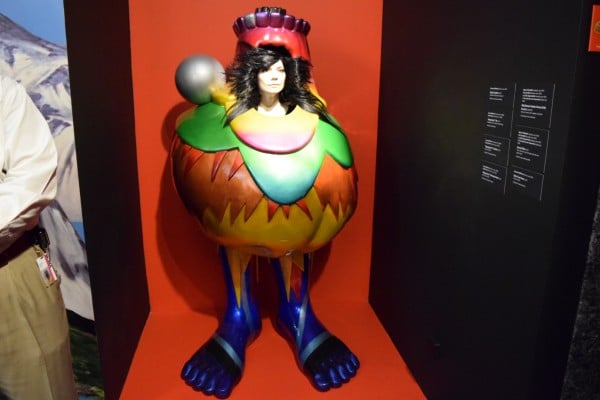
Bernhard Willhelm, Body Sculpture (2007).
Photo: Ben Davis.
What else? In a chamber on the floor below, the 10-minute-long MoMA-commissioned video Black Lake, from her just-released album Vulnicura (see Björk Will Release New Album Timed With MoMA Retrospective) plays on loop on two giant screens. To my eyes this is actually a very ordinary music video, featuring the always-magnetic singer literally beating her breast with emotion as she claws her way through an evocative volcanic landscape. Another screening room allows you to watch a program of some of Björk’s justly celebrated music videos. The lobby presents a few of the bespoke musical instruments she worked with over the years, including a hulking pendulum-swinging music-box contraption, which is fun to look at; and several organ-like devices, which are not.
I had things to say about “Björk” in advance; think-piece-y things about what it means for MoMA—which seems to be reorganizing itself to be something like a hipster lifestyle brand—to have picked Björk in particular as its inaugural pop-star to honor in this way; thoughts about how the fine-art model of the auteur that is being used to frame her work is in tension with the reality of the mass-cultural artifacts on view; thoughts about how the regnant post-studio, post-pop, performance-obsessed sensibility has created an art climate where it is not just acceptable but inevitable to honor celebrity itself as a kind of talent; other thoughts.
But none of these really matter because the show just doesn’t come off. It will attract a lot of visitors and ink, I think; the sad truth is that people care a lot more about a bad Björk show than they do about some old thing called “modern art.” But it bodes ill for MoMA’s pop-culture efforts, failing to make a case for a museum as a particularly good place to appreciate such figures. It neither convinces that it makes sense to present its subject as an artist (not even with the catalogue’s efforts to build her up into an expert on object-oriented ontology, the art world’s latest philosophical vogue), nor figures out a way to capture any of the excitement of her as a unique flavor of pop star. It’s just a bunch of stuff that you wander through in vague discomfort, and which attracts your interest mainly because Björk is somehow associated with it.
Back to the Swan Dress. Look closely. At the mannequin’s feet are two ovate forms. The detail shows that at least someone knows what’s up: MoMA has laid a colossal egg.
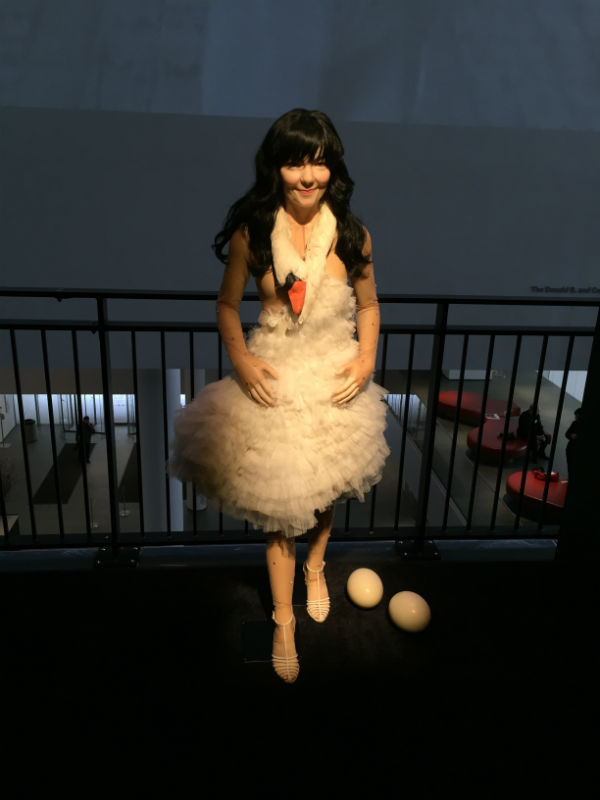
Marjan Pejoski’s Swan Dress in “Björk” at MoMA
Photo: Ben Davis
“Björk” is on view at the Museum of Modern Art through June 7. Read other articles by national art critic Ben Davis: What’s Really Going on at Abu Dhabi’s Saadiyat Island? and Why I Believe New York’s Art Scene Is Doomed. Meet Ben Davis in person at a VOLTA NY salon (organized in partnership with GalleryLog) on Sunday, March 8, at 1 PM on Pier 90.
